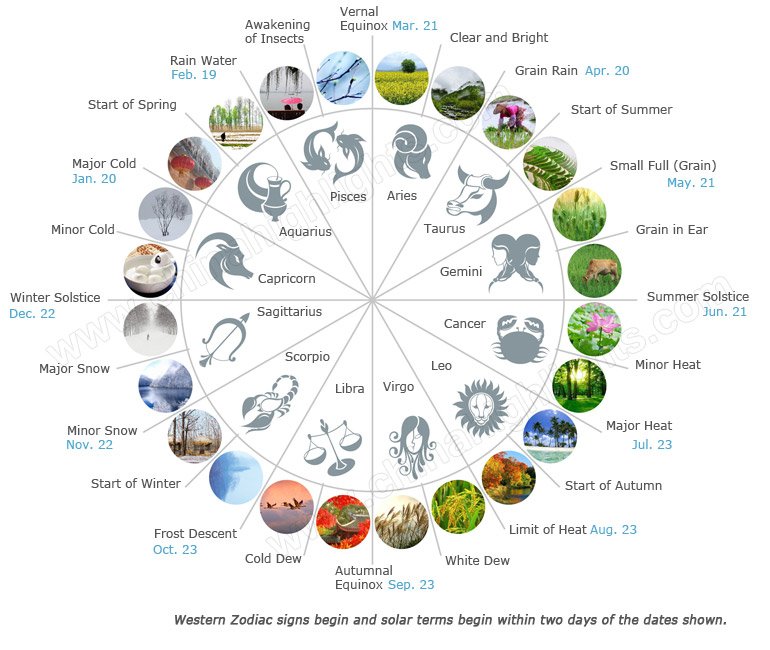
24 Solar Terms of China
24 Solar Terms of China
Solar Terms is a calendar of twenty-four periods and climate to govern agricultural arrangements in ancient China and functions even now.
These solar terms have meaningful titles. Some of them reflect the change of seasons such as the Start of Spring, the Start of Summer, the Start of Autumn, and the Start of Winter; some embody the phenomena of climate like the Awakening of Insects, and some indicate the change of climate like Rain Water, Grain Rain, Minor Heat, Major Heat, and so on.
Introduction of 24 Solar Terms
Highlight
On November 30, 2016, the UNESCO has inscribed China’s “The Twenty-Four Solar Terms” on the Representative List of the Intangible Cultural Heritage of Humanity.
Origin
As early as the Shang Dynasty (17th century BC – 1046 BC), the Chinese ancestors had already established four major solar terms. During the Zhou Dynasty (1046 – 256 BC), eight solar terms marking the four seasons were established: Start of Spring, Spring Equinox, Start of Summer, Summer Solstice, Start of Autumn, Autumn Equinox, Start of Winter, and Winter Solstice. Until the Han Dynasty (202 BC – 220 AD), the present 24 solar terms was established completely.
Meanings of 24 Solar Terms
These solar terms have meaningful titles. Some of them reflect the change of seasons such as the Beginning of Spring, the Beginning of Summer, the Beginning of Autumn, and the Beginning of Winter; some embody the phenomena of climate like the Waking of Insects (Jing Zhe), Pure Brightness (Qing Ming), Lesser Fullness of Grain (Xiao Man) and Grain in Beard (Mang Zhong); and some indicate the change of climate like Rain Water (Yu Shui), Grain Rain (Gu Yu), Lesser Heat (Xiao Shu), Greater Heat (Da Shu), and so on.
What is 24 Solar Terms
The solar terms include 24 phases hereinafter: 立春 Spring begins. 雨水 The rains. 惊蛰 Insects awaken. 春分 Vernal Equinox. 清明 Clear and bright. 谷雨 Grain rain. 立夏 Summer begins. 小满 Grain buds. 芒种 Grain in ear. 夏至 Summer solstice. 小暑 Slight heat. 大暑 Great heat. 立秋 Autumn begins. 处暑 Stopping the heat. 白露 White dews. 秋分 Autumn Equinox. 寒露 Cold dews. 霜降 Hoar-frost falls. 立冬 Winter begins. 小雪 Light snow. 大雪 Heavy snow. 冬至 Winter Solstice. 小寒 Slight cold. 大寒 Great cold.

Additionally, there is a locally famous song that has been spread for many centuries. And Chinese people named it The Song of 24 Solar Terms. What it includes exactly will be shown as below:
春雨惊春清谷天 |
chūn yǔ jīng chūn qīng gǔ tiān, |
24 Solar Terms in 2020
|
Solar Terms |
Date |
Meaning |
|---|---|---|
| Lesser Cold (Xiao Han) | Jan. 6th | It is rather cold |
| Greater Cold (Da Han) | Jan. 20th | The coldest moment of a year |
| The Beginning of Spring (Li Chun) | Feb. 4th | Spring begins |
| Rain Water (Yu Shui) | Feb. 19th | It begins to rain |
| The Waking of Insects (Jing Zhe) | Mar. 5th | Hibernating animals come to sense |
| The Spring Equinox (Chun Fen) | Mar. 20th | Day and night are equally long |
| Pure Brightness (Qing Ming) | Apr. 4th | It is warm and bright |
| Grain Rain (Gu Yu) | Apr. 19th | Rainfall is helpful to grain |
| The Beginning of Summer (Li Xia) | May 5th | Summer begins |
| Lesser Fullness of Grain (Xiao Man) | May 20th | Kernels plump |
| Grain in Beard (Mang Zhong) | Jun. 5th | Wheat grows ripe |
| The Summer Solstice (Xia Zhi) | Jun. 21st | It has the longest daytime and the shortest night of the year |
| Lesser Heat (Xiao Shu) | Jul. 6th | Torridity comes |
| Greater Heat (Da Shu) | Jul. 22nd | The hottest moment of a year |
| The Beginning of Autumn (Li Qiu) | Aug. 7th | Autumn begins |
| The End of Heat (Chu Shu) | Aug. 22nd | Heat hides |
| White Dew (Bai Lu) | Sep. 7th | Dew curdles |
| The Autumn Equinox (Qiu Fen) | Sep. 22nd | The mid of autumn |
| Cold Dew (Han Lu) | Oct. 8th | Dew is very cold |
| Frost’s Descent (Shuang Jiang) | Oct. 23rd | Frost descends |
| The Beginning of Winter (Li Dong) | Nov. 7th | Winter begins |
| Lesser Snow (Xiao Xue) | Nov. 22nd | it begins to snow |
| Greater Snow (Da Xue) | Dec. 7th | It snows heavily |
| The Winter Solstice (Dong Zhi) | Dec. 21st | The shortest daytime and the longest night of a year |












